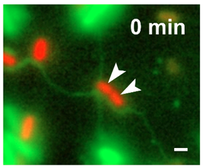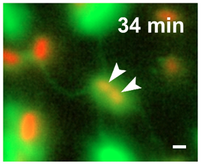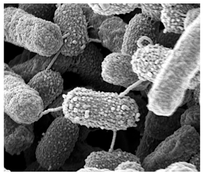|
Coculture experiments between two complementary genotypes that were unable to produce a certain amino acid, but produced others in increased amounts, revealed that bacterial cells did not exchange metabolites via diffusion through the extracellular environment, but by intercellular nanotubes. Auxotrophic bacteria used these membrane-derived structures to connect to other bacterial cells and use them to exchange cytoplasmic constituents such as amino acids or proteins. Strikingly, the formation of nanotubes was contingent on the nutritional status of cells and operated both within and between different bacterial species.
This project aims at investigating the molecular and physiological underpinnings of intercellular nanotubes, particularly focusing on their mode of functioning. For this purpose, a detailed genetic analysis is performed to identify the molecular basis of nanotube formation and the intercellular transfer of cytoplasmic materials. In addition, nanotube-forming cells are imaged using super-resolution and electron microscopy to shed light on the molecular mechanism of metabolite transport. Together, these experiments will provide fundamental insights into the structure and function of the newly discovered interbacterial nanotubes. |
Researchers:
Benedikt Pauli, Shiksha Ajmera, Christian Kost
Selected Publications:
Pande S, Shitut S, Freund L, Westermann M, Bertels F, Colesie C, Bischofs IB, Kost C.(2015). Metabolic cross-feeding via intercellular nanotubes among bacteria. Nature Communications, 6: 6238. doi:10.1038/ncomms7238.




